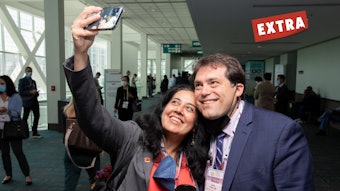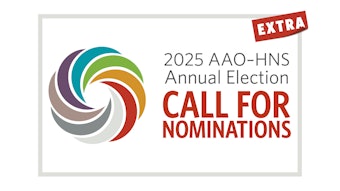CI in Older Adults with Asymmetric Hearing Loss
A review of the potential benefits of and considerations for cochlear implantation in older adult patients.
Nicholas J. Thompson, MD, Richard K. Gurgel, MD, MSCI, Margaret T. Dillon, AuD, PhD, and Kevin D. Brown, MD, PhD, on behalf of the Implantable Hearing Device Committee

Traditional treatment options for adults with AHL used to consist of observation, or the fitting of a hearing aid, a contralateral routing of the signal (CROS or Bi-CROS) hearing aid, or a bone conduction hearing aid (BCHA). Adults with AHL typically experienced significant improvements in speech recognition, spatial hearing, and perceived abilities with cochlear implant (CI) use as compared to pre-operative abilities. Unfortunately, cochlear implantation for AHL is not currently covered by the Centers for Medicare & Medicaid (CMS), excluding many older adults who may benefit from this technology.
Outcomes of CI Use for Adults with AHL
Cochlear implant users with AHL experience significant performance improvements when listening with the CI alone and when listening in the combined condition (CI plus the contralateral ear) as compared to pre-operative abilities. For example, Buss and colleagues reported that average word recognition in the affected ear significantly improved from 4% pre-operatively (with a hearing aid) to 55% at 12 months post-activation with the CI.3 In the combined condition, adults with AHL experience significant improvements in speech recognition in challenging background noise and sound source localization as compared to pre-operative abilities.3-6 They also report significant improvements in perceived abilities and suppression of tinnitus with CI use.6,7
Importantly, studies comparing performance with CI use to traditional technologies for AHL (e.g., BCHA) also find significantly better performance with the CI. For example, Arndt and colleagues evaluated outcomes for CI recipients with AHL who had previously undergone test periods of both BCHA and CROS hearing aids.8 Results showed an improvement in localization ability as well as speech comprehension in various testing configurations with CI use as compared to the other treatment options. A follow-up study evaluated 89 participants who chose between a CROS, BCHA, and CI.9 Localization again was found to be improved in the CI group, and no difference in either the BCHA or CROS group compared to the unaided condition. These differences are likely due to the CI stimulating the auditory pathway for the affected ear (providing the patient with bilateral stimulation and binaural cues); whereas alternative devices route the signal to the contralateral ear and stimulate only one auditory pathway. The bilateral advantage provided to adults with AHL from CI use is what supports the significant improvements in speech recognition, sound source localization, and perceived benefits as compared to alternative options (e.g., unaided or rerouting technologies).
For conventional CI candidates (e.g., bilateral moderate-to-profound SNHL), advanced age is not a contraindication for surgery. Outcomes for older adult CI users do tend to be poorer than outcomes for younger adult CI users, but still provide substantial objective and subjective improvement. Importantly, older adult CI users experience significant improvements in performance as compared to their own baseline measures.10-15 Advanced age may affect outcomes due to poorer hearing thresholds in the contralateral ear, reduced auditory processing, and/or poorer cognitive abilities.
Asymmetric Hearing Loss and Cognitive Function
There is a well described association between hearing loss and cognitive decline in older adults. It is estimated that hearing loss is associated with “dose” dependent 1.7- to 4-fold increased odds of developing dementia, depending on the severity of hearing loss.16-18 In the 2024 Lancet Commission on dementia prevention, intervention, and care, hearing loss was identified as the modifiable risk factor with the greatest attributable risk, accounting for ~7% of overall modifiable risk.19
Most of the studies evaluating the association between hearing loss and dementia have focused on presbycusis, or bilateral sensorineural hearing loss (SNHL). There is growing evidence that any form of auditory deprivation, even conductive hearing loss, is associated with increased odds of developing dementia.20 This may also apply to patients with AHL.
Although there is a paucity of data from large epidemiologic or prospective studies showing the cognitive impact of AHL, there is a growing body of literature, specifically with imaging data, that demonstrates the impact of SSD on the brain.21 Brain function and connectivity, as measured by functional MRI scan of individuals with dementia, are impacted by side-specific hearing loss, with left ear loss showing a greater impact on brain function.22 Tsai et al. have shown upregulation in the brain’s visual pathway activity (i.e. a redirection of brain activity away from auditory and toward visual) and downregulation of the somatomotor pathways after unilateral hearing loss.23 Similarly, Li et al. demonstrated alteration of the structural network connections in SSD, especially in cognitive-related networks, which showed a close correlation with hearing abilities.24
Cochlear Implants, Asymmetric Hearing Loss, and Cognitive Function
Treating hearing loss, with either hearing aids or CIs (depending on the severity of the hearing loss) can improve cognitive function in older adults.25,26 For hearing aids, this was recently shown in the first prospective randomized, controlled trial—the ACHIEVE trial—demonstrating improved cognitive function in patients with hearing loss and impaired cognition or at risk for developing dementia.27 For older CI candidates with bilateral, severe-profound SNHL, meta-analyses and systematic reviews have shown similar cognitive benefits of implantation have been shown on specific cognitive tasks.28,29
Although there have been few studies evaluating the cognitive impact of CI on older adults with AHL, there are a number of studies that demonstrate improvement in domains that are likely correlated to cognition. A number of hearing benefits of CI in older patients with AHL have been determined.30,31 There is a normalization of brain activity, as shown on PET imaging and specifically during an auditory voice/non-voice discrimination task, in patients with AHL after implantation.32 Cortical auditory responses improve after cochlear implantation in patients with AHL.33 Cochlear implant use also improves health-related quality of life for patients with AHL, as well as decreasing tinnitus and cognitive distress.34 Despite the numerous studies showing improved brain activity following cochlear implantation in patients with AHL, there is still a gap in our knowledge in understanding how implants may affect cognition in older adults with AHL.
Cochlear Implant Use for Older Adults with Asymmetric Hearing Loss
Data are limited as to the influence of advanced age on outcomes for CI users with AHL; however, the available data suggest that older adults with AHL benefit from CI use—though not always at the level of younger adults within the first year of CI use. A recent study by Johnson and colleagues evaluated the outcomes of CI use for 18 older adults (≥65 years at surgery) with AHL who underwent cochlear implantation as part of a clinical trial.30 As observed in other samples of adult CI users with AHL, participants experienced significant improvements in word recognition in the affected ear. At the pre-operative visit with a hearing aid, average word recognition was 8%. Performance significantly improved with CI use, with average scores of 51% at 12 months post-activation and 50% at 5 years post-activation. Participants also experienced significant improvements in speech recognition in noise and sound source localization when listening in the combined condition. For example, the average RMS error was 76 degrees pre-operatively, 40 degrees at 12 months post-activation, and 41 degrees at 5 years post-activation.
The study by Johnson and colleagues also evaluated perceived abilities using the Speech, Spatial, and Qualities of Hearing (SSQ) scale and perceived tinnitus severity using the Tinnitus Handicap Inventory (THI).30 For the SSQ, participants perceived a significant improvement in abilities in all three subscales (Speech Hearing, Spatial Hearing, and Qualities of Hearing) with CI use. The most pronounced differences were noted for the Spatial Hearing subscale, which includes questions related to sound source localization. There were no participants who were non-users of their CI. Participants also reported significant reductions in tinnitus severity with CI use, which was maintained out to 5 years post-activation. These trends were similar to prior studies in younger adult CI recipients with UHL or AH.35-37
Together these data demonstrate that older adults with AHL experience significant benefits with CI use as compared to their pre-operative abilities. These data together with emerging data on the cognitive impacts of AHL on older adults demonstrate the need to extend this indication to CMS beneficiaries.
References
- U.S. Food and Drug Administration, Center for Devices and Radiological Health. MED-EL Cochlear Implant System for expanding the indications to include single-sided deafness and asymmetric hearing loss. April 2019.
- U.S. Food and Drug Administration, Center for Devices and Radiological Health. Nucleus 24 Cochlear Implant System, Expanded Device Indications. January 2022.
- Buss E, Dillon MT, Rooth MA, et al. Effects of cochlear implantation on binaural hearing in adults with unilateral hearing loss. Trends Hear. 2018;22:2331216518771173. doi:10.1177/2331216518771173
- Dillon MT, Buss E, Anderson ML, et al. Cochlear implantation in cases of unilateral hearing loss: initial localization abilities. Ear Hear. 2017;38(5):611-619. doi:10.1097/AUD.0000000000000430
- Dillon MT, Rooth MA, Canfarotta MW, Richter ME, Thompson NJ, Brown KD. Sound Source Localization by Cochlear Implant Recipients with Normal Hearing in the Contralateral Ear: Effects of Spectral Content and Duration of Listening Experience. Audiol Neurootol. 2022;27(6):437-448. doi:10.1159/000523969
- Dillon MT, Buss E, Rooth MA, et al. Cochlear implantation in cases of asymmetric hearing loss: subjective benefit, word recognition, and spatial hearing. Trends Hear. 2020;24:2331216520945524. doi:10.1177/2331216520945524
- Thompson NJ, Dillon MT, Buss E, et al. Subjective Benefits of Bimodal Listening in Cochlear Implant Recipients with Asymmetric Hearing Loss. Otolaryngol Head Neck Surg. 2020;162(6):933-941. doi:10.1177/0194599820911716
- Arndt S, Aschendorff A, Laszig R, et al. Comparison of pseudobinaural hearing to real binaural hearing rehabilitation after cochlear implantation in patients with unilateral deafness and tinnitus. Otol Neurotol. 2011;32(1):39-47. doi:10.1097/MAO.0b013e3181fcf271
- Jakob TF, Speck I, Rauch A-K, et al. Bone-anchored hearing system, contralateral routing of signals hearing aid or cochlear implant: what is best in single-sided deafness? Eur Arch Otorhinolaryngol. 2022;279(1):149-158. doi:10.1007/s00405-021-06634-7
- Vermeire K, Brokx JPL, Wuyts FL, Cochet E, Hofkens A, Van de Heyning PH. Quality-of-life benefit from cochlear implantation in the elderly. Otol Neurotol. 2005;26(2):188-195. doi:10.1097/00129492-200503000-00010
- Murr AT, Canfarotta MW, O’Connell BP, et al. Speech recognition as a function of age and listening experience in adult cochlear implant users. Laryngoscope. 2021;131(9):2106-2111. doi:10.1002/lary.29663
- Horn KL, McMahon NB, McMahon DC, Lewis JS, Barker M, Gherini S. Functional use of the Nucleus 22-channel cochlear implant in the elderly. Laryngoscope. 1991;101(3):284-288. doi:10.1288/00005537-199103000-00011
- Labadie RF, Carrasco VN, Gilmer CH, Pillsbury HC. Cochlear implant performance in senior citizens. Otolaryngol Head Neck Surg. 2000;123(4):419-424. doi:10.1067/mhn.2000.109759
- Haensel J, Ilgner J, Chen Y-S, Thuermer C, Westhofen M. Speech perception in elderly patients following cochlear implantation. Acta Otolaryngol. 2005;125(12):1272-1276. doi:10.1080/00016480510044214
- Carlson ML, Breen JT, Gifford RH, et al. Cochlear implantation in the octogenarian and nonagenarian. Otol Neurotol. 2010;31(8):1343-1349. doi:10.1097/MAO.0b013e3181edb69d
- Thomson RS, Auduong P, Miller AT, Gurgel RK. Hearing loss as a risk factor for dementia: A systematic review. Laryngoscope Investig Otolaryngol. 2017;2(2):69-79. doi:10.1002/lio2.65
- Lin FR, Metter EJ, O’Brien RJ, Resnick SM, Zonderman AB, Ferrucci L. Hearing loss and incident dementia. Arch Neurol. 2011;68(2):214-220. doi:10.1001/archneurol.2010.362
- Lin FR, Yaffe K, Xia J, et al. Hearing loss and cognitive decline in older adults. JAMA Intern Med. 2013;173(4):293-299. doi:10.1001/jamainternmed.2013.1868
- Livingston G, Huntley J, Liu KY, et al. Dementia prevention, intervention, and care: 2024 report of the Lancet standing Commission. Lancet. 2024;404(10452):572-628. doi:10.1016/S0140-6736(24)01296-0
- Urdang ZD, Jain A, Li M, et al. Conductive hearing loss associates with dementia, and middle ear reconstruction mitigates this association: A multinational database study. Otol Neurotol. 2024;45(9):1078-1086. doi:10.1097/MAO.0000000000004308
- Heggdal POL, Brännström J, Aarstad HJ, Vassbotn FS, Specht K. Functional-structural reorganisation of the neuronal network for auditory perception in subjects with unilateral hearing loss: Review of neuroimaging studies. Hear Res. 2016;332:73-79. doi:10.1016/j.heares.2015.11.015
- Aylward A, Naidu SR, Mellum C, et al. Left Ear Hearing Predicts Functional Activity in the Brains of Patients with Alzheimer’s Disease Dementia. Ann Otol Rhinol Laryngol. 2021;130(4):343-349. doi:10.1177/0003489420952467
- Tsai P, Latypov TH, Hung PS-P, et al. Structural connectivity changes in unilateral hearing loss. Cereb Cortex. 2024;34(6). doi:10.1093/cercor/bhae220
- Li X, Qiao Y, Shen H, Niu Z, Shang Y, Guo H. Topological reorganization after partial auditory deprivation-a structural connectivity study in single-sided deafness. Hear Res. 2019;380:75-83. doi:10.1016/j.heares.2019.05.010
- Yeo BSY, Song HJJMD, Toh EMS, et al. Association of Hearing Aids and Cochlear Implants With Cognitive Decline and Dementia: A Systematic Review and Meta-analysis. JAMA Neurol. 2023;80(2):134-141. doi:10.1001/jamaneurol.2022.4427
- Carasek N, Lamounier P, Maldi IG, et al. Is there benefit from the use of cochlear implants and hearing aids in cognition for older adults? A systematic review. Front Epidemiol. 2022;2:934750. doi:10.3389/fepid.2022.934750
- Lin FR, Pike JR, Albert MS, et al. Hearing intervention versus health education control to reduce cognitive decline in older adults with hearing loss in the USA (ACHIEVE): a multicentre, randomised controlled trial. Lancet. 2023;402(10404):786-797. doi:10.1016/S0140-6736(23)01406-X
- Hamerschmidt R, Santos VM, Gonçalves FM, et al. Changes in cognitive performance after cochlear implantation in adults and older adults: a systematic review and meta-analysis. Int J Audiol. 2023;62(6):521-532. doi:10.1080/14992027.2022.2050823
- Amini AE, Naples JG, Hwa T, et al. Emerging Relations among Cognitive Constructs and Cochlear Implant Outcomes: A Systematic Review and Meta-Analysis. Otolaryngol Head Neck Surg. 2023;169(4):792-810. doi:10.1002/ohn.344
- Johnson BR, Dillon MT, Thompson NJ, et al. Benefits of cochlear implantation for older adults with asymmetric hearing loss. Laryngoscope. August 2024. doi:10.1002/lary.31718
- Wesarg T, Aschendorff A, Baumgaertel R, et al. Cochlear Implantation in Single-Sided Deafness and Asymmetric Hearing Loss: 12 Months Follow-up Results of a European Multicenter Evaluation. J Int Adv Otol. 2024;20(4):289-300. doi:10.5152/iao.2024.231457
- Strelnikov K, Karoui C, Payoux P, et al. Adaptive Strategies of Single-Sided Deaf Cochlear-Implant Users Revealed Through Resting State Activity: an Auditory PET Brain Imaging Study. Hear Res. 2024;451:109079. doi:10.1016/j.heares.2024.109079
- Legris E, Galvin J, Roux S, Aoustin J-M, Bakhos D. Development of cortical auditory responses to speech in noise in unilaterally deaf adults following cochlear implantation. PLoS One. 2020;15(9):e0239487. doi:10.1371/journal.pone.0239487
- Häußler SM, Köpke V, Knopke S, Gräbel S, Olze H. Multifactorial positive influence of cochlear implantation on patients with single-sided deafness. Laryngoscope. 2020;130(2):500-506. doi:10.1002/lary.28007
- Thompson NJ, Dillon MT, Buss E, et al. Long-Term Improvement in Localization for Cochlear Implant Users with Single-Sided Deafness. Laryngoscope. 2022;132(12):2453-2458. doi:10.1002/lary.30065
- Thompson NJ, Lopez EM, Dillon MT, et al. Cochlear Implantation for Unilateral and Asymmetric Hearing Loss: Long-Term Subjective Benefit. Laryngoscope. 2023;133(10):2792-2797. doi:10.1002/lary.30608
- Thompson NJ, Brown KD, Buss E, Rooth MA, Richter ME, Dillon MT. Long-Term Binaural Hearing Improvements for Cochlear Implant Users with Asymmetric Hearing Loss. Laryngoscope. 2023;133(6):1480-1485. doi:10.1002/lary.30368




















